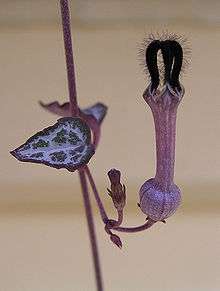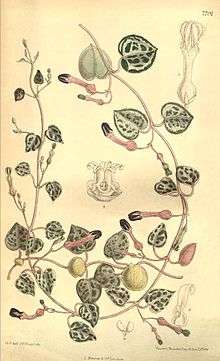Ceropegia woodii
| Ceropegia woodii | |
|---|---|
 | |
| Ceropegia woodii | |
 | |
| Curtis's Botanical Magazine | |
| Scientific classification | |
| Kingdom: | Plantae |
| (unranked): | Angiosperms |
| (unranked): | Eudicots |
| (unranked): | Asterids |
| Order: | Gentianales |
| Family: | Apocynaceae |
| Genus: | Ceropegia |
| Species: | C. woodii |
| Binomial name | |
| Ceropegia woodii | |
| Synonyms[1] | |
| |
Ceropegia woodii is a flowering plant in the genus Ceropegia (Apocynaceae), native to South Africa, Swaziland, and Zimbabwe. It is sometimes treated as a subspecies of the related Ceropegia linearis, as C. linearis subsp. woodii.[1] Common names include chain of hearts, collar of hearts, string of hearts, rosary vine, hearts-on-a-string and sweetheart vine.
History
The species was discovered in 1881 by John Medley Wood, curator of the Durban Botanic Gardens, hanging from rocks on Groenberg in Natal at an altitude of 1800 feet. Thirteen years later, in 1894, he sent a living plant to Kew. Its trailing habit, neat appearance and tolerance of neglect, made it an ideal plant for hanging baskets. The plant that had been sent to Kew subsequently flowered, providing the material for Plate 7704 of Curtis's Botanical Magazine published in 1900. The prolific botanical artist Matilda Smith prepared the plate, while the Kew taxonomist N. E. Brown produced a detailed description, naming the plant after its discoverer.[2][3]
Description
It is an evergreen succulent trailing vine that grows to 10 centimetres (3.9 in) in height and spreads to reach up to 2–4 metres (6 ft 7 in–13 ft 1 in) in length. Its leaves are shaped like hearts, about 1–2 cm wide and long. When exposed to sufficient light they have a deep green colour; under insufficient lighting the leaves are pale green. With age it develops a woody caudex at its base. The roots, and occasionally the stems, will often develop tubers. On the stems these form at nodes and are likely the reason for the common name of rosary vine.
The flower is in general form similar to those of other Ceropegia species. The corolla grows to 3 cm in length and is a mixed colouring of off-white and pale magenta. The five petals are a deeper purple.
Cultivation and uses
Ceropegia woodii is tender, and in temperate regions is a very popular houseplant, often grown in hanging baskets so the long trailing branches can hang down with their leaves spaced out like a row of large beads. Several cultivars have been selected, some with variegated leaves. It requires excellent drainage, should be watered only when dry, and should never stand in water. Excess water should be removed from plant saucer after watering. It can be grown outdoors only in subtropical and tropical areas, with a minimum temperature of 15 °C. Partial shading is useful when the plant is grown outdoors.
This plant has gained the Royal Horticultural Society's Award of Garden Merit[4](confirmed 2017).[5]
References
- "Ceropegia woodii". Germplasm Resources Information Network (GRIN). Agricultural Research Service (ARS), United States Department of Agriculture (USDA).
- Ceropegia Woodii. Rosary-Vine, Heart-Vine
- 1 2 "The Plant List: A Working List of All Plant Species". Retrieved July 7, 2014.
- ↑ Curtis's Botanical Magazine vol. 126
- ↑ Herbert F. J. Huber: Revision of the genus Ceropegia. In: Memórias da Sociedade Broteriana, Volume 12, 1957, S.1-203, Coimbra
- ↑ "Ceropegia linearis subsp. woodii". Royal Horticultural Society. Retrieved 22 July 2013.
- ↑ "AGM Plants - Ornamental" (PDF). Royal Horticultural Society. July 2017. p. 16. Retrieved 24 January 2018.
External links
| Wikimedia Commons has media related to Ceropegia woodii. |